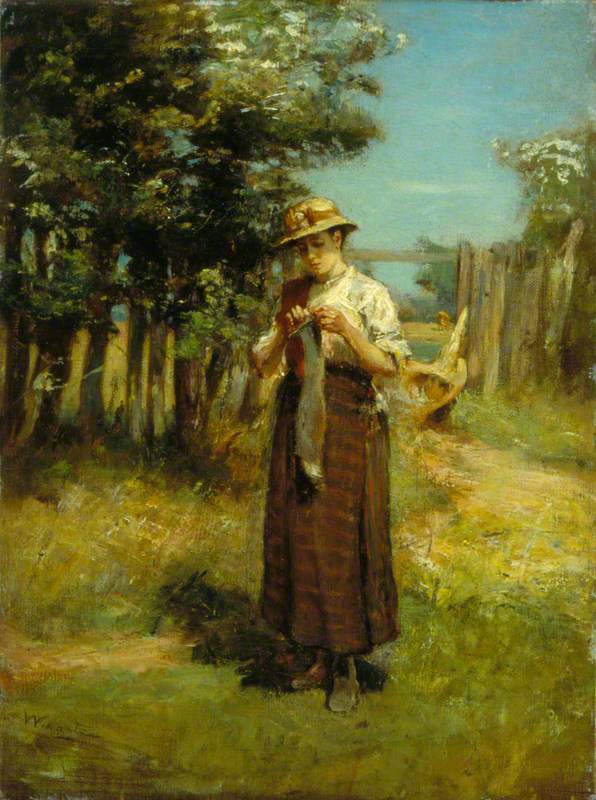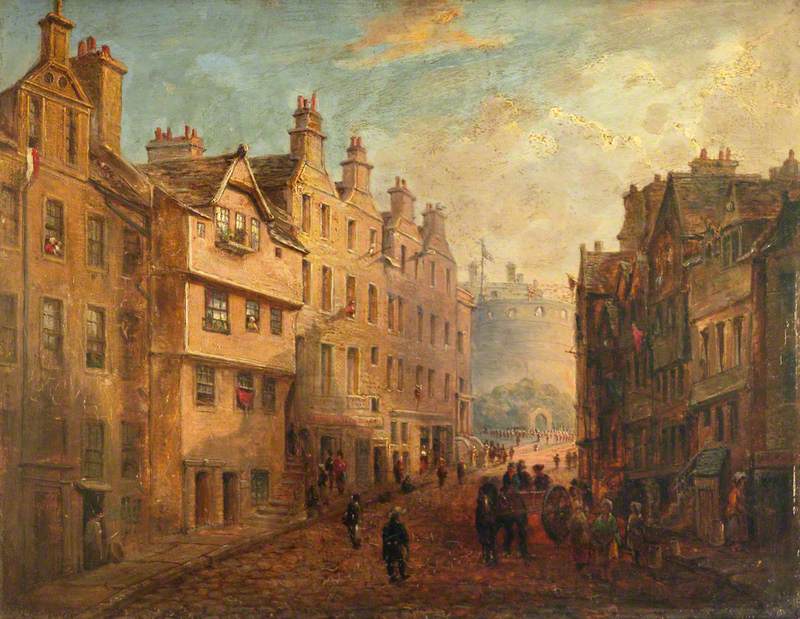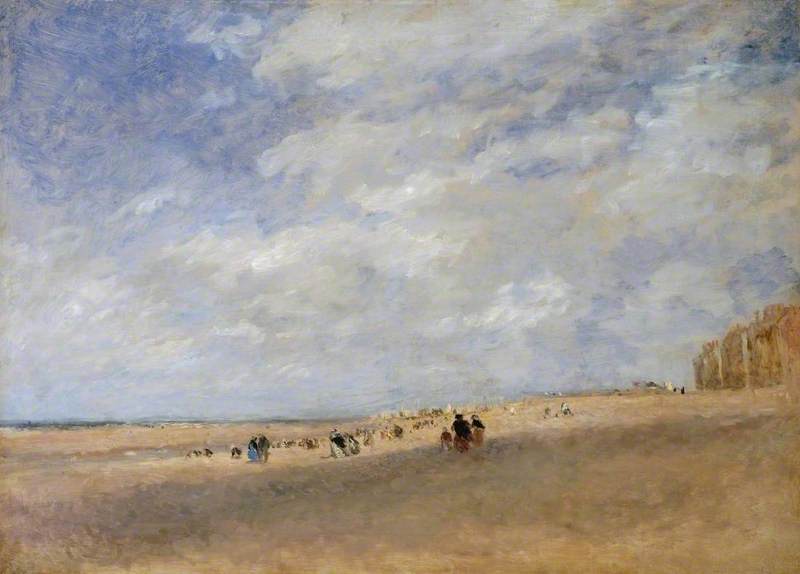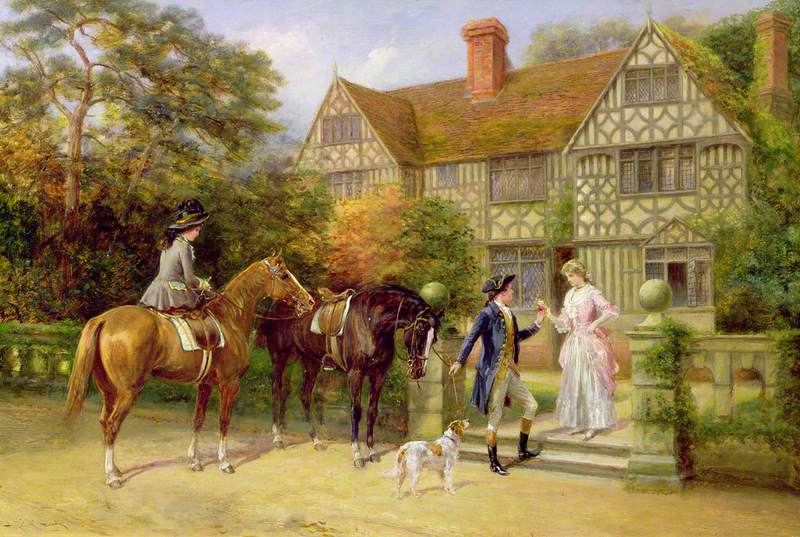Early 2020 saw one of its biggest challenges in recent memory. Covid-19 impacted everyone and changed the way we live and work.
This new way of life presented us with different opportunities, such as exploring our local outdoor spaces and re-engaging with nature. Many of us took walks or bike-rides closer to home. These wanders, or meanderings, were one positive thing to come out of the situation. We invite you to take a wander through these evocative landscapes, they may even inspire your next walk. This has been a difficult time, but many of us have rediscovered things that were so easily missed before.
So as the nights grow longer, and the weather grows colder, we invite you to take a step back, relax, and have a meander.
-
The Assignation
The AssignationHeywood Hardy was an English painter who specialised in animal paintings and hunting scenes. By contrast, this painting depicts a moment of calm. A woman walks down a dirt road surrounded by trees. An assignation is a meeting in secret, usually between two lovers. In her hand she holds a book, but her facial expression implies she has other things on her mind.
Heywood Hardy (1842–1933)
Oil on canvas
H 22 x W 37 cm
The Stirling Smith Art Gallery & Museum
-
Harvest Moon
Harvest MoonWilliam J Kennedy was one of the Glasgow Boys, the group of artists inspired by new developments in the art world such as Impressionism. He studied at Paisley School of Art and possibly also at Glasgow School of Art, and from 1880 to 1885 he spent much of his time in France, studying in Paris. On his return to Scotland he settled near Stirling.
This painting of a moon-lit night is thought to date from when Kennedy was living in Stirling. It depicts a quiet village. An orange harvest moon rises on the horizon. Kennedy uses rich, dark colours and thick paint strokes to capture the feeling of a walk on a summer night.
William J. Kennedy (1859–1918)
Oil on canvas
H 49.5 x W 67.5 cm
The Stirling Smith Art Gallery & Museum
-
Blairlogie Village
Blairlogie VillageThis painting depicts Blairlogie village in winter. Although the painting is set in a cold and bleak season, the artist has painted it in a variety of bright colours. The artist, James Edward Philips, lived in Blairlogie, moving there after serving in the First World War. He was a furniture designer but created paintings such as this one in his spare time.
James Edward Phillips (b.1895)
Oil on board
H 67 x W 74.5 cm
The Stirling Smith Art Gallery & Museum
-
Black Beast Wanderer
Black Beast Wanderer 1887–1890Joseph Donovan Adam was born in Glasgow in 1841, the son of landscape painter, Joseph Adam. He was largely taught by his father, and received formal training at the Langham Chambers and the Royal Scottish Academy. In 1887 he established his 'Country Atelier' at Craigmill House in Stirling, an art school with a focus on animals. He is most well-known for his paintings of highland cattle.
In this dramatic painting, a black highland cow is caught in the wind on a snowy hillside. The darkness of the cow’s fur is a striking contrast against the snow. Adam captures the scene by using variety of brush strokes. The white snow is actually a variety of yellows, blues, and purples.
Joseph Denovan Adam (1841–1896)
Oil on canvas
H 52 x W 35.2 cm
The Stirling Smith Art Gallery & Museum
-
Rain – Man on Horseback
Rain – Man on Horseback 1800–1850David Cox is considered one of the great English landscape painters, and a major figure of the Golden Age of English watercolour. From 1805 his works were exhibited regularly at the Royal Academy, and he became well-known for his atmospheric watercolour depictions of the British countryside and coast. His work is similar to John Constable and J. M. W. Turner.
In this watercolour, a man on horseback is struggling against wind and rain. He holds on to his hat as he braves the gales of rain. A small dog runs along behind the horse. This small watercolour shows Cox’s skill in capturing the fleeting nature of weather, atmosphere, and light.
David Cox the elder (1783–1859)
Watercolour on paper
H 18.1 x W 26.1 cm
The Stirling Smith Art Gallery & Museum
-
Winter Wanderings
Sometimes we only associate winter with being cold and wet, but winter can also be beautiful. These works of art capture the brilliance of the seasonal elements and invite us to coorie in for the long nights ahead.
Can you remember the last time it snowed?
When was the last time you saw such a majestic highland bull?
Where is your favourite place to walk during snowfall?
-
Leisure Moments
Leisure Moments 1874Initially beginning a career as a commercial Clerk in Glasgow, James Lawton Wingate used his savings to travel to Italy to study art and then returned to Scotland to study at the Royal Scottish Academy. He specialised in landscape painting and was increasingly influenced by the Impressionists.
In this painting, Wingate’s admiration for impressionist painting can be seen. It depicts a young woman walking down a path. While she walks, she occupies her time by either darning a stocking or knitting. The title implies that even in her leisure moments, this young woman must keep busy.
James Lawton Wingate (1846–1924)
Oil on canvas
H 39.5 x W 29.5 cm
The Stirling Smith Art Gallery & Museum
-
A Northerly Breeze
A Northerly Breeze 1870Joseph Henderson began his career an apprentice draper but was allowed to study part-time at Edinburgh’s major art school, the Trustee’s Academy. After his self-portrait was accepted by the Royal Scottish Academy, he gave up the drapery trade for portrait painting. He would go on to also paint landscapes, seascapes, and coastal scenes.
Like many Scottish painters at the time, Henderson was influenced by the Impressionists and that influence is apparent in this painting. It depicts two women collecting shellfish on the Ayrshire coast. The women wear layers of protective clothing to shield themselves from the waves that crash against the rocks.
Joseph Henderson (1832–1908)
Oil on canvas
H 44.2 x W 74.5 cm
The Stirling Smith Art Gallery & Museum
-
On the Fife Coast
On the Fife Coast 1860–1878Although born in England, Bough became one of the most influential figures in the development of nineteenth-century Scottish landscape painting. A largely self-taught artist, he spent the early part of his career in Manchester and Glasgow painting scenes for theatrical sets. Bough later dedicated himself to landscape painting and became adept at illustrating the fleeting effects of weather.
In this oil painting, a beach in Fife is depicted. Fishermen work together to heave a boat into the water as dawn breaks on the horizon. Sunlight is just beginning to cast light on the wet sand of the beach and cottages in the distance.
Samuel Bough (1822–1878)
Oil on canvas
H 35 x W 45.4 cm
The Stirling Smith Art Gallery & Museum
-
The Landing Place, Stirling, with the Ochil Hills in the Distance
The Landing Place, Stirling, with the Ochil Hills in the Distance 1853Henry G Duguid was primarily a painter of landscapes and buildings, working mainly in oil and watercolour. Duguid's subject matter was largely confined to views of Edinburgh, and consequentially he produced an invaluable record of the city's appearance prior to its extensive remodelling over the subsequent decades.
In this painting, Dugaid is more interested in depicting the Forth River in Stirling. Boats can be seen along the river and people walk down paths on the riverside. Stirling Castle is seen in the background as well as Cambuskenneth Abbey tower even though it is on the other side of the Forth. It appears Dugaid wanted to fit all of Stirling’s landmarks into one painting.
Henry Gibson Duguid (1805–1860)
Oil on canvas
H 63.7 x W 90.2 cm
The Stirling Smith Art Gallery & Museum
-
Waterfront Walks
Scotland is surrounded by water, with many lochs and rivers running through it, so our shorelines have a special place in our lives and imaginations. Bodies of water are places of both work and leisure as well as a natural frontier in which to explore.
What type of sounds do you think you would hear if you were in these paintings?
What are your favourite fishing villages or seaside towns to visit?
Do you prefer to watch the sun rise or set?

















